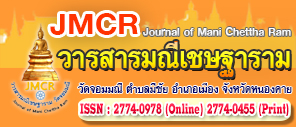อิทธิพลของปัจจัยทางการตลาดและการตลาดดิจิทัลที่ส่งผลต่อการตัดสินใจซื้อของผู้บริโภคในประเทศไทย
คำสำคัญ:
ปัจจัยทางการตลาด, ปัจจัยทางการตลาดดิจิทัล, การตัดสินใจซื้อของผู้บริโภคบทคัดย่อ
งานวิจัยนี้มีวัตถุประสงค์ คือ 1) เพื่อศึกษาปัจจัยทางการตลาด ปัจจัยทางการตลาดดิจิทัล และการตัดสินใจซื้อของผู้บริโภคในประเทศไทย 2) เพื่อตรวจสอบอิทธิพลระหว่างปัจจัยทางการตลาด ปัจจัยทางการตลาดดิจิทัล และการตัดสินใจซื้อของผู้บริโภคในประเทศไทย ใช้วิธีการวิจัยเชิงปริมาณเพื่อรวบรวมข้อมูลจากผู้ใช้อินเทอเน็ตในการเลือกซื้อสินค้าหรือใช้บริการผ่านทางเครือข่ายอินเทอร์เน็ตหรือผ่านแอพพลิเคชั่นออนไลน์ในประเทศไทย กลุ่มตัวอย่าง จำนวน 384 คน กำหนดโดยใช้ตารางของเครจซี่และมอร์แกนที่ระดับความเชื่อมั่นร้อยละ 95 และเลือกโดยวิธีการแบบบังเอิญ (accidental sampling) การวิเคราะห์ข้อมูลใช้สถิติประกอบด้วย ค่าความถี่ ค่าร้อยละ ค่าเฉลี่ย ค่าเบี่ยงเบนมาตรฐาน การวิเคราะห์สหสัมพันธ์ของเพียร์สัน และการวิเคราะห์สมการโครงสร้าง
ผลการวิจัยพบว่า 1) ปัจจัยทางการตลาด ปัจจัยทางการตลาดดิจิทัล และการตัดสินใจซื้อของผู้บริโภคในประเทศไทย อยู่ในระดับมาก 2) อิทธิพลระหว่างปัจจัยทางการตลาด ปัจจัยทางการตลาดดิจิทัล และการตัดสินใจซื้อของผู้บริโภค มีนัยสำคัญทางสถิติที่ระดับ .01 ด้วยค่าสถิติ c2= 68.856, df= 55, p= .099, c2/df=1.252, GFI= .932 และ RMSEA= .041 โดยอิทธิพลระหว่างตัวแปรในแบบจำลองสมมติฐานสรุปได้ดังนี้ คือ ปัจจัยทางการตลาดมีอิทธิพลทางตรงเชิงบวกต่อปัจจัยทางการตลาดดิจิทัลและการตัดสินใจซื้อของผู้บริโภค และปัจจัยทางการตลาดดิจิทัลมีอิทธิพลทางตรงเชิงบวกต่อการตัดสินใจซื้อของผู้บริโภค ข้อค้นพบสามารถให้ข้อมูลเชิงลึกที่สามารถนำไปพัฒนากลยุทธ์ทางการตลาดที่ออกแบบให้ตรงและสอดคล้องกับความชอบและความต้องการของผู้บริโภคเพื่อขับเคลื่อนการเติบโตที่ยั่งยืนของธุรกิจในภูมิทัศน์การค้ายุคใหม่
เอกสารอ้างอิง
ธนาคารไทยพาณิชย์. (2565). 7 ขั้นตอนการทำตลาดออนไลน์สำหรับมือใหม่. เรียกใช้เมื่อ 12 ตุลาคม 2566, จาก https://www.scb.co.th/th/personal-banking/stories/business-maker/7-steps-online-marketing.html
สำนักงานพัฒนาธุรกรรมทางอิเล็กทรอนิกส์. (2564). รายงานผลการสำรวจพฤติกรรมผู้ใช้อินเทอร์เน็ตในประเทศไทย ปี 2563, สำนักงานพัฒนาธุรกรรมทางอิเล็กทรอนิกส์ (สพธอ.) กระทรวงดิจิทัลเพื่อเศรษฐกิจและสังคม เรียกใช้เมื่อ 12 ตุลาคม 2565, จาก https://www.etda.or.th/th/newsevents /pr-news/ETDA-released-IUB-2020.aspx
Aaker, J. L.; Benet-Martinez, V. and Garolera, J. (2001). Consumption Symbols as Carriers of Culture: A Study of Japanese and Spanish Brand Personality Constructs. Journal of Personality & Social Psychology, 81(3), 492-508.
Browne, M. and Cudeck, R. (1993). Alternative ways of assessing model fit. In K. A. Bollen, J. S. Ling (Eds.). Testing structural equation models. Beverly Hill, CA: Sage.
Byrne, B. (2001). Structural equation modeling with AMOS: Basic concept, application, and programming. New Jersey: Lawrence Erlbaum Associate.
Chaffey, D. and Ellis-Chadwick, F. (2019). Digital Marketing: Strategy, Implementation, and Practice (7th ed.). Pearson Education.
Cronbach, L. J. (1951). Coefficient alpha and the internal structure of tests. Psychometrika, 16(3), 297-334.
Euromonitor International. (2022). Thailand Country Profile. Retrieved on December 15, 2023 from https://www.euromonitor.com/thailand
Hambleton, R. K. (1984). Validating the test scores. In R. A. Berk. (Ed). A guide to criterion-referenced test construction. (199–223). Baltimore and London: The Johns Hopkins University Press.
Kline, R. (2005). Principle and practice of structural equation modeling. New York: The Guilford Press.
Krejcie, R. and Morgan. D. (1970). Determining Sample Size for Research Activities. Educational and Psychological Measurement, 30(3), 607–610.
Kotler, P. and Keller, K. L. (2020). Marketing Management (15th ed.). Pearson Education.
Likert, R. (1932). A technique for the measurement of attitude. Archives of Psychology,
, 1-55.
Phua, J.; Jin, S. V. and Kim, J. (2017). Gratifications of Using Facebook, Twitter, Instagram, or Snapchat to Follow Brands: The Moderating Effect of Social Comparison, Trust, Tie Strength, and Network Homophily on Brand Identification, Brand Engagement, Brand Commitment, and Membership Intention. Telematics and Informatics, 34(1), 412-424.
Schumacker, R., & Lomax, R. (2004). A beginner's guide to structural equation modeling. (2nd ed.). New Jersey: Lawrence Erlbaum Associates Publishers.
Usunier, J. C. and Lee, J. A. (2018). Marketing across Cultures (7th ed.). Pearson Education.



